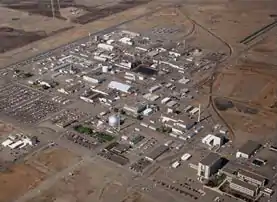300 Area
The 300 Area is part of the Hanford Site in the state of Washington, USA. The area was originally used for the production of fuel for nuclear reactors and for performing research on improving the production process, however most modern work being done focuses on environmental research. After a decade of demolition activities, the surplus 300 Area facilities, with the exception of the 324 Blg, have been torn down. Today, the few buildings that remain active are laboratories, workshops, and offices.[1] It is operated by the Pacific Northwest National Laboratory.

The 300 area is a restricted-access area to maintain safety due to industrial use. The soil around the complex in several locations is contaminated as described in the 300 Area final record of decision. There are waste burial grounds to the north with higher level radiation that have had hundreds of thousands of tons of soil removed.
Closure
Fluor Hanford, Inc. began the 300 Area Accelerated Closure Plan in 2000 when re-industrialization failed to grow as expected.[1] Staff were moved from the aging post-World War II era buildings (326, 329) to newly constructed buildings on the Pacific Northwest National Laboratory (PNNL) main campus.[2] By moving in the early 2000s, earlier than the originally planned 2046, the office of science estimates savings of maintaining the outdated facility at $1.5 billion.[1]
Notes
- "Hanford Site: 300 Area". US Department of Energy. 2006-12-13. Archived from the original on 2008-09-17. Retrieved 2015-12-10.
- "PNNL: CRL: 300 Area Transition". Pacific Northwest National Laboratory. August 2009. Archived from the original on 2010-05-28. Retrieved 2009-08-25.
References
- "HANFORD SITE (Hanford 100 Area, Hanford 200 Area, Hanford 300 Area)" (PDF). Archived (PDF) from the original on 24 August 2009. Retrieved 2009-08-25.
- "The Hanford 300 Area Cleanup Plan – Insufficient, Dangerous, and Against Best-Known Findings" (PDF). Retrieved 2009-08-25.
- "The Hanford 300 Area Record of Decision". United States Department of Ecology. Retrieved 2017-10-02.